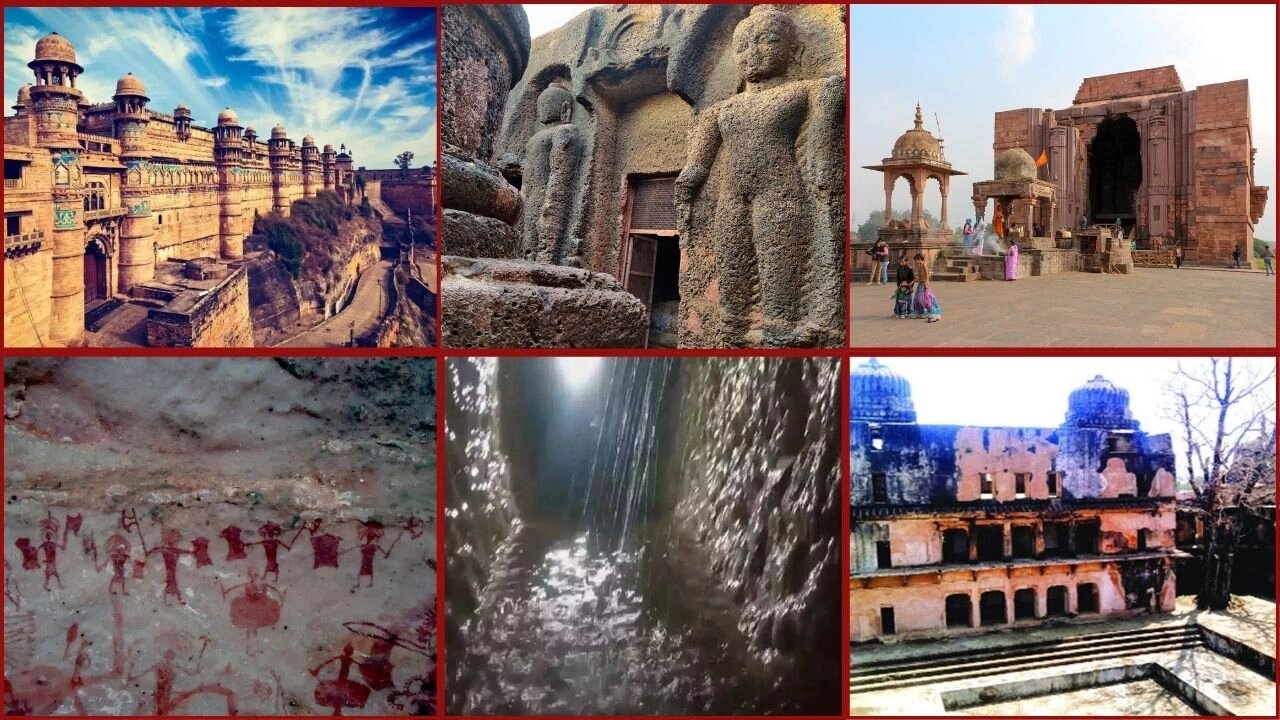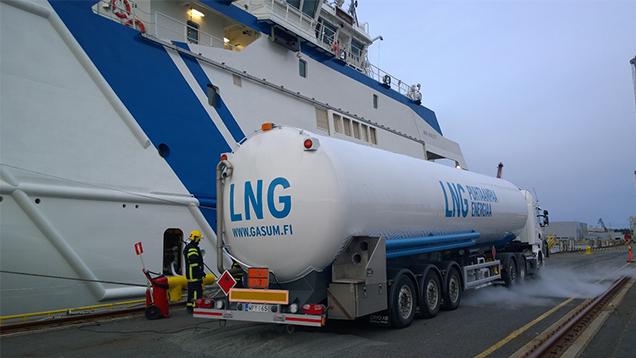Six Heritage Sites on Tentative UNESCO List

- 20 Mar 2024
Why is it in the News?
In a significant boost to its rich cultural and historical legacy, 6 new sites from Madhya Pradesh have found a place in the tentative UNESCO list of World Heritage Sites (WHS).
Six New Sites From MP In the UNESCO Tentative List:
- The sites included in the tentative list are Gwalior Fort, the Historical Group of Dhamnar, Bhojeshwar Mahadev Temple, Rock Art Sites of Chambal Valley, Khooni Bhandara, Burhanpur, and God Memorial of Ramnagar, Mandla.
- The UNESCO tentative list includes those that provide a forecast of the properties that a State Party may decide to submit for inscription in the next five to ten years.
- Gwalior Fort: An imposing fortress atop a hill, featuring impenetrable walls, exquisite sculptures, and stunning architecture.
- Built-in the 6th century AD by Rajput warrior Suraj Sen and expanded by Tomar ruler Maan Singh in 1398.
- Dhamnar Caves: Rock-cut temple site in Mandsaur district, constructed in the 7th century AD.
- It comprises 51 caves, stupas, chaityas, and dwellings, with a colossal Gautam Buddha statue.
- Bhojeshwar Mahadev Temple: Located near Bhopal, this temple is dedicated to Lord Shiva, with a huge Linga carved from a single stone.
- Built between 1010 and 1053 AD by Raja Bhoj but was never completed.
- Chambal Valley Rock Art Sites: The world's largest concentration of rock art sites across MP, Rajasthan, and Uttar Pradesh, depicting ancient daily life, rituals, and hunting scenes.
- Khooni Bhandara: A unique water supply system built in Burhanpur in 1615 by ruler Abdurrahim Khankhana, still operational today.
- Gond Statue, Mandla: Moti Mahal, a five-storied palace built in Mandla in 1667 by Gond king Hriday Shah, showcasing the strong willpower of the king despite limited resources.
What is UNESCO’s Tentative List?
- A World Heritage Site is a site with outstanding universal value.
- It also denotes cultural and natural significance that transcends national boundaries and is of common importance for current and future generations of all humanity.
- According to UNESCO, a tentative list lists the properties each State Party intends to consider for nomination.
- The government of any nation must have a nomination document ready for the UNESCO World Heritage Committee to review once as soon as UNESCO includes it in a location on the Tentative List.
- After this, a UNESCO representative will evaluate the situation and inspect it.
What is the Tentative List Process?
- The States Parties are encouraged to submit their Tentative Lists of properties that they consider cultural and natural heritage of outstanding universal value and, therefore, suitable for inscription on the World Heritage List.
- The States Parties are encouraged to prepare their Tentative Lists with the participation of stakeholders such as site managers, local and regional governments, local communities, NGOs, and other interested parties and partners.
- The States Parties should submit the Tentative Lists to the World Heritage Centre at least one year before submitting any nomination.
- The list should not be exhaustive.
- The States Parties can re-examine and re-submit their list at least every ten years.
- The States Parties are also requested to submit their lists using a submission format (English or French) that should contain the name of the properties, geographical location, a brief description of the properties, and why the property is of outstanding universal value.
- Nomination will only be considered once the property is added to the State Party's Tentative List.
State of Global Climate Report 2023

- 20 Mar 2024
Why is it in the News?
In line with a host of observations by climate agencies in the preceding three months, the World Meteorological Organisation (WMO) has officially confirmed 2023 to be the hottest year on record.
About the State of Global Climate Report 2023:
- Published annually by the World Meteorological Organization (WMO), the State of Global Climate Report provides a detailed analysis of the Earth's climate system.
- Contributors to the report include various UN organizations, National Meteorological and Hydrological Services, Global Data and Analysis Centers, Regional Climate Centres, the World Climate Research Programme (WCRP), and more.
Highlights of the 2023 Report:
- Record-Breaking Global Temperatures: 2023 was the hottest year on record, with a global average near-surface temperature of 1.45°Celsius (±0.12°C) above the pre-industrial baseline.
- The past ten years were also the warmest decade recorded.
- Extensive Marine Heatwaves: Nearly one-third of the global ocean experienced a marine heatwave on an average day in 2023.
- Over 90% of the ocean had faced heatwave conditions at some point during the year, negatively impacting ecosystems and food systems.
- Unprecedented Glacier Ice Loss: Preliminary data reveals the largest loss of ice since 1950 for the global set of reference glaciers, driven by extreme melt in western North America and Europe.
- Surge in Renewable Energy Capacity: Renewable capacity additions in 2023 increased by almost 50% from 2022, totaling 510 gigawatts (GW) and marking the highest rate in the past two decades.
- These findings emphasize the pressing need to address climate change through effective international cooperation, policymaking, and sustainable practices.
About the World Meteorological Organisation (WMO):
- The World Meteorological Organization (WMO) is a specialized agency of the United Nations that fosters international cooperation in atmospheric science, climatology, hydrology, and geophysics.
- Founded in 1950, WMO originated from the International Meteorological Organization established in 1873 to facilitate the exchange of weather data and research.
- Today, WMO comprises 193 member countries and territories and promotes the free exchange of meteorological and hydrological data, information, and research.
- By collaborating with various partners, WMO contributes to environmental protection, climate change mitigation, and sustainable development efforts worldwide.
- Headquarters: Geneva, Switzerland.
Small-Scale LNG (SSLNG)

- 20 Mar 2024
Why is it in the News?
India's largest gas utility GAIL (India) Ltd commissioned the country's first SSLNG unit at its Vijaipur complex in Madhya Pradesh recently.
India Unveils Its First Small-Scale LNG Plant:
- In a significant step towards a cleaner energy mix, GAIL (India) Ltd. has commissioned India's first Small-Scale LNG (SSLNG) plant in Vijaipur, Madhya Pradesh.
- This plant will produce 36 tonnes of Liquefied Natural Gas (LNG) daily, utilizing cutting-edge technology like treatment skids and liquefaction skids to convert natural gas into LNG.
- As part of India's commitment to increasing the proportion of natural gas in its primary energy mix from 6% to 15% by 2030, the SSLNG plant will play a pivotal role in reducing pollution emissions while catering to the nation's growing energy demands.
- This milestone achievement paves the way for a greener future and positions India as a significant player in the global LNG landscape.
What is Small-Scale LNG?
- Small-scale LNG (SSLNG) is an emerging industry that offers a novel approach to natural gas distribution.
- While there is no standard international definition, SSLNG typically involves the liquefaction and transportation of natural gas in smaller quantities using specialized trucks and vessels.
- This allows for the supply of LNG to industrial and commercial consumers in regions without pipeline connectivity.
- SSLNG can be sourced from existing large-scale LNG import terminals or small liquefaction plants in gas-rich locations.
- End-users regasify the LNG using small vaporizers for traditional use cases like supplying Compressed Natural Gas (CNG) for vehicles and piped gas for households and industries.
- Alternatively, LNG can be supplied in its liquid form for direct use.
Benefits of Small-Scale LNG (SSLNG):
- Expanded Accessibility: SSLNG overcomes the constraints of traditional pipeline infrastructure, enabling natural gas delivery to regions previously lacking access.
- This opens new avenues for cleaner fuel alternatives and widespread energy availability.
- Operational Flexibility: SSLNG's modular design allows for rapid deployment in response to local demand fluctuations, making it an ideal solution for remote locations, industrial environments, and diverse transportation requirements.
- Sustainability Promotion: By fostering the adoption of cleaner fuels, SSLNG significantly reduces emissions in various transportation sectors, including trucks, buses, and marine vessels. This contributes to a greener future and combats climate change.
- Strengthened Energy Security: Decentralized SSLNG distribution systems diversify fuel sources and bolster energy security, ensuring reliable and stable energy supply amid global fluctuations and uncertainties.
Challenges of Small-Scale LNG (SSLNG) Implementation:
- Vehicle Availability Constraints: Limited options for LNG-powered vehicles impede the widespread adoption of LNG as a fuel source, underscoring the need for increased production and diversification of vehicle models.
- Insufficient Retail Infrastructure: The lack of a well-established LNG retail network hinders convenient consumer access to LNG fuel, emphasizing the importance of infrastructure expansion and enhancement.
- Higher Upfront Investment: The comparatively higher initial costs of LNG vehicles compared to traditional diesel options may deter potential buyers, necessitating innovative financial solutions and incentives.
- Financing Barriers: The absence of dedicated financing options for LNG vehicles poses obstacles for interested buyers, requiring tailored financial instruments to support SSLNG uptake.
- Restricted Pipeline Coverage: SSLNG faces logistical challenges in areas without existing natural gas pipeline networks, highlighting the need for infrastructure development to extend its reach to remote regions.
- Regulatory and Permitting Hurdles: SSLNG projects may encounter regulatory and permitting setbacks, including environmental and safety concerns, potentially prolonging project timelines and inflating costs.
- Addressing these challenges is essential for expediting SSLNG implementation and fostering its growth.
FSSAI Launches Comprehensive Lab Network for Pathogen Testing

- 20 Mar 2024
Why is it in the News?
With food poisoning and diarrhea becoming a common occurrence, the Food Safety and Standards Authority of India (FSSAI) is working towards creating a network of 34 microbiology labs across the country that will be equipped to test food products for 10 pathogens, including E coli, salmonella, and listeria.
About the Initiative:
- To address the growing concern of microbial contamination in food products, a network of 34 advanced microbiology laboratories has been established across the country.
- These state-of-the-art facilities are specifically designed to test and monitor a wide range of food products for the presence of harmful pathogens, including E. coli, salmonella, and listeria, among others.
- The nationwide initiative aims to strengthen the existing food safety framework by enhancing the early detection and prevention of foodborne illnesses.
- By analyzing food samples collected during routine surveillance, the labs will play a pivotal role in ensuring the safety and quality of consumable goods.
- With a focus on safeguarding public health and well-being, this collaborative effort will contribute significantly to the overall improvement of food security and foster greater confidence in the food industry.
- As the network continues to expand and evolve, it will undoubtedly become an essential asset in the ongoing battle against foodborne pathogens and contamination.
Need for the Initiative:
- India has witnessed a surge in food poisoning and diarrhea cases in recent years, emphasizing the critical need for improved food safety measures.
- According to data from the National Centre for Disease Control (NCDC), over 1,100 outbreaks of acute diarrhoeal disease and around 550 incidents of food poisoning occurred within the last four years.
- These troubling statistics underscore the urgency to address this pressing public health issue.
- State food safety laboratories, responsible for ensuring the safety of consumable products, currently lack the necessary resources and infrastructure to effectively identify and mitigate the presence of dangerous pathogens.
- The complexities of maintaining live reference samples, the high costs of reagents, and the requisite expertise of microbiologists pose significant challenges in maintaining optimal food safety standards.
- Consequently, the establishment of a comprehensive microbiology lab network becomes crucial in effectively addressing the growing threat of foodborne illnesses.
- By enhancing testing capabilities and promoting early detection, this initiative will ultimately contribute to a safer food supply, improved public health outcomes, and increased consumer confidence in the food industry.
About the Food Safety and Standards Authority of India (FSSAI):
- As an autonomous body under India's Ministry of Health and Family Welfare, the FSSAI was established in 2006 under the Food Safety and Standards Act.
- This act serves as a consolidating statute focusing on food safety and regulation in India.
- The FSSAI's mission is to set global standards for food, encourage adherence to these standards, promote good manufacturing and hygiene practices, and enable citizens' access to safe and nutritious food.
Key functions include:
-
- Protecting public health by regulating and supervising food safety.
- Setting standards and guidelines for food articles.
- Issuing licenses, registrations, and accreditations for food businesses.
- Controlling food imports to prevent harmful ingredients.
- Accrediting food testing laboratories nationwide.
- Overseeing food certification in India, including accreditation of certification systems and food safety management systems for food businesses.
- Through these efforts, the FSSAI plays a vital role in maintaining high food safety standards and safeguarding the well-being of India's citizens.
Reverse Flipping

- 20 Mar 2024
Why is it in the News?
Payments major Pine Labs and quick commerce firm Zepto are among the startups looking to relocate their headquarters from foreign shores to India, to capitalize on the country's burgeoning tech landscape.
What is Reverse Flipping?
- Reverse flipping is a growing trend where overseas startups relocate their domicile to India and list on Indian stock exchanges.
- The primary motivation behind this shift is the potential for a higher valuation and more certain exit opportunities in India's thriving economic landscape.
Several factors contribute to the rise of reverse flipping:
- Access to a large, expanding economy: India's significant market size and sustained economic growth offer foreign startups attractive prospects for business expansion and success.
- Abundant venture capital: India's substantial venture capital resources provide a strong financial foundation for startups, fueling innovation and growth.
- Favorable tax policies: The country's tax regulations encourage foreign startups to establish operations in India, helping them maximize profits and minimize costs.
- Enhanced intellectual property protection: India's robust IP protection framework fosters innovation and creativity, safeguarding the unique ideas and technologies of startups.
- Skilled, youthful workforce: The availability of a talented, young, and educated population provides startups with a valuable human resource pool to drive growth and success.
- Supportive government policies: The Indian government actively promotes entrepreneurship and innovation through various initiatives and policies, creating a conducive environment for startups.
- The Economic Survey 2022-23 acknowledged the importance of reverse flipping and suggested measures to expedite the process, including simplifying tax vacation procedures, ESOP taxation, capital movement, and reducing tax layers.
- These efforts aim to further enhance India's appeal as a destination for foreign startups and foster economic growth.
What is Flipping?
- Flipping refers to the process by which an Indian company becomes a 100% subsidiary of a foreign entity after moving its headquarters overseas, involving a transfer of intellectual property (IP) and other assets.
- This transforms an Indian startup into a fully-owned subsidiary of a foreign entity, with founders and investors maintaining their ownership through the new overseas structure by exchanging their shares.
The process of flipping poses several concerns for India:
- The brain drain of entrepreneurial talent: As Indian startups move their operations overseas, India experiences a loss of innovative and entrepreneurial talent, which could otherwise contribute to the country's economic growth and development.
- Value creation in foreign jurisdictions: Flipping redirects potential value creation to foreign countries, depriving India of the economic benefits that could result from successful startups and innovations.
- Loss of Intellectual Property: When companies relocate and transfer their intellectual property overseas, India loses valuable IP assets, undermining the country's competitive advantage and innovation potential.
- Reduced tax revenue: Flipping also contributes to decreased tax revenue for India as companies shift their operations and profits to other jurisdictions, which may have more favorable tax policies.
